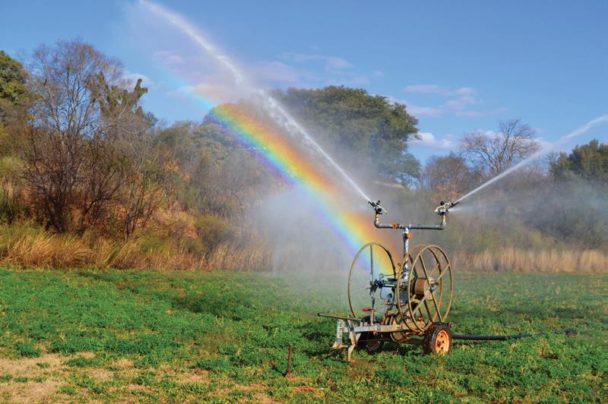Fertiliser products are available in a water soluble granular, powder or liquid form. The choice between the different types will depend on the storage space available, the available injectors, product stability, ease of handling, injection method, cost and the acidification possibility of the fertiliser.
Based on the primary fertiliser content (N, P, K), fertiliser is given a name consisting of three parts. This relationship demonstrates the quantity of nitrogen (N), phosphate (P), and potassium (K) content of the fertiliser in terms of its weight percentage. The compilation of a fertigation programme will mostly be the result of the production objectives of the farmer, the physiological stage of the crop, the chemical compound of the irrigation water and the soil, as well as the irrigation system in use.
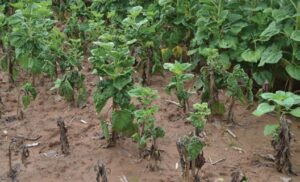
Micro element deficiencies lead to all sorts of deformities and discolouration in crops.
Two concepts are relevant when referring to fertigation. The first is when fertiliser products are applied by means of an irrigation system. A timescale is applicable here, for example the nutrients can be applied annually, weekly or even daily. This approach does not mean that the nutrients must be present in the irrigation water each time that irrigation is applied. Single elements, such as only nitrogen, or a combination of elements, such as a combination of nitrogen, phosphate and potassium, can be applied together. In general, the shorter the time scale, the more balanced, more expensive and more plant absorbent the fertigation programme will be.
With localised wetting irrigation systems, for example drip systems, the crop usually has an intensive localised root system. The time scale reduces drastically, and nutritional supplement must be given at short intervals, for example by maintaining continuous nutritional balances within the root zone.
The second approach is that water for irrigation must be enriched with nutrients and every time irrigation is applied, completely balanced nutrient elements must be present. This approach is referred to in general as the hydroponic approach and where it is applied under field conditions, it is known as the open hydroponic approach. Where this nutritional approach is followed, the nutrients and the pH of the irrigation water are controlled by means of an irrigation computer and adjusted to the physiological stage of the plant.
Fertiliser concentration can be indicated as kilogram or litre per hectare, kilogram or litre per cubic metre irrigation water and electrical conductivity (EC) at or without a certain pH. Electrical conductivity (EC) is an indication of the irrigation water’s natural salt content and the composition of the fertiliser mixture. If a certain quantity of a certain fertiliser product is applied in water, it will indicate a certain electrical conductivity value. This value is proportional to the quantity of the product in the water, and EC can therefore be used to determine and control the quantity of nutrients applied.
The ideal water pH for irrigation is between 5,6 and 6,2, because in this pH range, elements are absorbed best by plants. Plants adapt to a certain pH and EC, and a large deviation from this causes plants to use the energy they should have used for production to adapt to new conditions. This results in accompanying reduction or discontinuance of growth and production. The aim should be to expose plants to constant EC and pH levels as far as possible with the open system. Hydroponicscan lead to maximum production that is not possible by any other means.

Nitrogen, phosphate and potassium are the three primary components of chemical fertiliser and the relation will always be indicated by the N:P:K format.
Nitrogen
Nitrogen is the element mostly required and therefore applied the most. A suitable nitrogen (N) concentration depends on the production objectives and crop requirements. Movement of nitrogen through the soil and absorbency of the nitrogen source depend on the type of nitrogen source and percentage available nitrogen in the source. Different soils will show different reactions with nitrogen through the water, and the correct choice of the N-source can, in some cases, result in a significant difference in yield. At low application levels, ammonium (NH4 +), which is positive and therefore adsorbs the negative clay particles, will have the result that the movement thereof is limited in the soil. As soon as the ammonium application is increased and the exchanging capacity of the soil is overcome, the movement of ammonium through the soil will also increase at a rate which depends on the soil type. At a soil temperature of 25°C to 30°C, the ammonium will be biologically transformed to a nitrate (NO3 -). This process is called nitrification. If the soil remains too wet as a result of irrigation or rain, the transformation will occur very slowly due to a lack of oxygen.
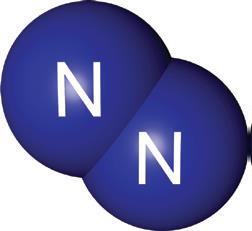
Nitrogen molecule (N2). Photo: Wikipedia.org.
Where the soil and irrigation water have a pH of 7 or higher, ammonium will transform into NH3 (ammonium gas) and a nitrogen loss can occur by means of evaporation. The solubility of urea is good, is not easily absorbed by the soil and therefore moves into the soil easily ― deeper than for instance, ammonium. After the hydrolysis from urea to ammonium, the reactions will be the same as discussed under ammonium.
Nitrate (NO3 -) is negatively charged exactly like clay particles, and therefore the antagonism has the result that the NO3 – ions are not strongly bound to the soil particles. The NO3 – ions usually move to the edge of the wetted area. If over-irrigation occurs, the nitrate can be leached out of reach of the plant roots. Any form of applied nitrogen will eventually be transformed to a nitrate form in the soil and the nitrogen application should therefore take place either periodically or through the irrigation water, or by means of water enrichment on a permanently balanced manner. Except for leaching, denitrifying can result in great nitrogen losses.
During the process, NO3 – changes to volatile N-forms. This usually occurs when there is too much water and consequently too little oxygen in the soil. Effective scheduling is therefore a prerequisite to ensure maximum yields under nutritional fertilisation. If NH4 + ions are dominant in the soil, H+ ions will be withdrawn from the root zone, which will lead to the acidification of the soil solution. The amount of calcium-carbonate required to neutralise the acidity of a specific fertiliser type, is called the calcium carbonate equivalent.
When the NO3- ion is mainly absorbed, HO-, or HCO3 – ions will be released with a consequent increase in the pH of the soil solution. High soil pH will reduce the availability of zinc, iron and phosphates for the plant.
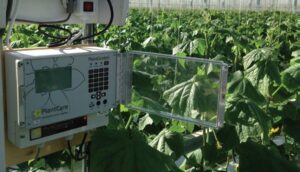
An irrigation computer. Photo: plant-care.ch.
Phosphate
The nutritional phosphate requirements of a crop are the highest during the germination phase or directly after planting. If the water pH (> 7,5) and especially water with bicarbonate (HCO3 -) as well as the Ca and Mg content high, sediments of Ca2 + and Mg2 + phosphates occur very fast. With certain reservations, phosphoric acid can be applied, but the pH must be monitored closely. This must however not be done without the advice of a professional. An incorrect recommendation can result in sedimentation with consequently the total blockage of the entire system. Where pH and the amount of Ca2 + and Mg2+ and HCO3-
ions are low, very few problems will be experienced with P applications. A low pH (< 5,5) for long periods can, in the long run, increase the possibility of corrosion of metal equipment and damage the plant roots.
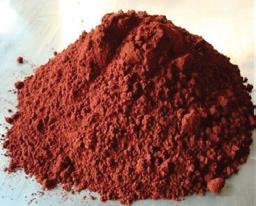
Red phosphorus powder. Photo: alchetron.com
Potassium
Potassium seldom causes problems such as blockages and precipitates within irrigation lines. The most general sources of potassium, namely potassium sulphate, (K2SO4), potassium chloride (KCl), and potassium nitrate (KNO3) are reasonably soluble in water and will not cause serious problems.
Potassium sulphate and potassium nitrate are preferred over potassium chloride, especially with crops which are salt sensitive. As soon as the potassium is applied, the K cation, K+, will adsorb on the clay particles. When the exchange complex of the clay is saturated, the K+ can descend reasonably easy and move sideways in the soil.
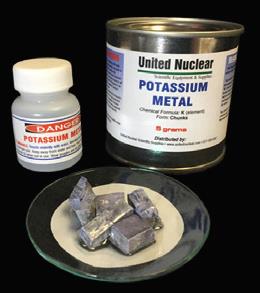
Potassium metal. Photo: unitednuclear.com.
Micro elements
Micro elements or trace elements are plant nutrients taken up by plants in very small quantities, but they play an essential role in the physiology of the plant. In the absence of one or more of these elements, normal growth and reproduction are not possible. When a shortage of micro-elements is experienced, plants show obvious shortage symptoms. The most important microelements essential for the normal development of the plants are iron, manganese, boron, copper, zinc, silicon and molybdenum.
Published with acknowledgement to the ARC Agricultural Engineering for the use of their fertigation manual. Visit www.arc.agric.za for more information.

